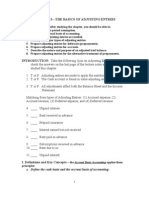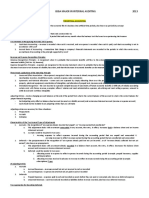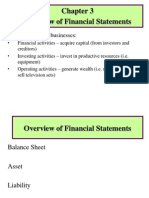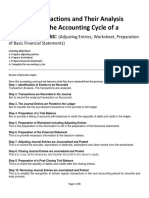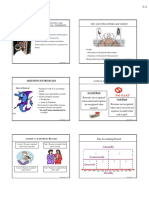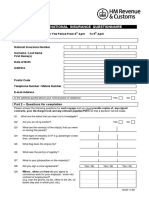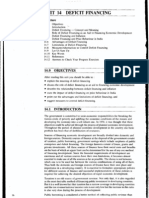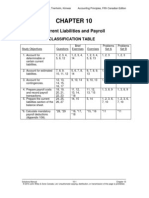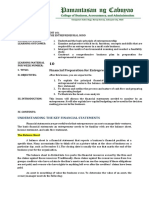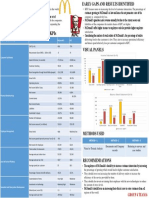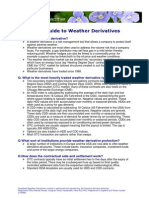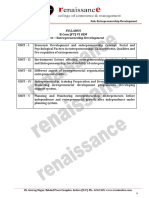International Accounting department
Accounting 101
Chapter 3
Adjusting the Accounts (part 1 – Introduction and Deferrals)
The Time period :
One of the main accounting assumptions is the “Time period Assumption” (And is sometimes called the
“Periodicity assumption”), this assumption states that the economic life of a business is divided into
Equal time periods (Annually : One year , semi-annually : half a year OR six months , Quarterly : A
quarter of a year OR 3 months , and monthly).
A year can have two forms :
I. Fiscal year : An accounting time period that consists of 12 months , and can have a start point at
any date , but must be for 12 months (Example : Jordan Co. is using the fiscal year , and the
accounting period starts on the 1st of February 2021 , and so this accounting period will end on
the 31st of January 2022 , which represents 12 months).
II. Calendar year : A period that consists of 12 months , but must start on the 1st of January and
end on the 31st of December (and by doing so it goes in accordance with the Calendar , and thus
it is named the Calendar year).
The Accrual basis VS. the Cash Basis :
The Cash basis : in the cash basis transactions (Revenues and Expenses) are recorded when Cash is
exchanged (with no consideration as to whether in the case of revenues the service was provided or not ,
and no consideration as to whether in the case of expenses the service was received by the company or
not). Note: The cash basis is NOT accepted under the IFRS
Benefits of Cash Basis:
The Cash basis is advantageous because it is simpler and less expensive than accrual accounting. (For
some small business owners and independent contractors who carry no inventory, it is a suitable
accounting practice. Many small businesses avoid employing accountants and using complex accounting
systems when using this method because of its ease of use. It also gives an accurate picture of how much
cash is on hand).
Disadvantages of Cash :
The cash-basis is not without disadvantages. It can paint an inaccurate picture of a business's Financial
health and growth. (For example, a business can experience a decline in sales one month but if a large
number of clients pay their Bills in the same period, cash-basis accounting can be misleading by showing
an increase of cash ,while in reality sales were not increasing).
1|P a g e
�The Accrual basis : in the accrual basis transactions (Revenues and expenses) are recorded when earned
(in the case of Revenues) or Incurred (in the case of Expenses) (with no consideration as to whether the
cash was received in the case of Revenues , and no consideration as whether the cash was paid in the
case of expenses) Note: the Accruals basis in accepted under the IFRS.
Benefits of the Accrual basis:
The accrual basis gives a more detailed and accurate picture of a business’s financial health and Growth
(For example, a business can experience a decline in sales one month but if a large number of clients pay
their Bills in the same period, accrual-basis accounting can show the reality behind these transactions
and inform the business and the external users of what is truly happening).
Disadvantages of the accrual basis:
Accrual basis requires that transactions be recorded when they occur rather than when money is
exchanged.(Indicating the presence of profits before actually receiving the cash can be dangerous. This
requires a lot of estimation that could cause problems down the line if invoices do not match the actual
events that occur in the future). And The rules and regulations related to the accrual basis seem to be
endless. Nobody will argue the fact that the cash method is a lot easier when managing a business’s
finances. If calculations are done incorrectly it could lead to inaccurate revenue and expense numbers
leading to overspending and losing profit. (and so, the Accrual basis requires intense effort and more
time to complete correctly).
The Revenue recognition principal:
Revenue recognition is an accounting principle that identifies the specific conditions in which revenue is
recognized and determines how to account for it. Typically, revenue is recognized when a critical event
(a service has been provided or a good has been sold) has occurred, and Does not take into
consideration whether Cash was exchanged (received) , and so falls under the Accrual’s basis of
accounting.
The Matching principal (the Expense recognition principal):
Is an accounting concept that dictates that companies report expenses (they have incurred) at the same
time as the revenues they are related to. Revenues and expenses are matched on the income statement
for a period of time , And so in the Expense recognition principal expenses are recognized when the
service or product that the company desires has been received by the company , not when cash is
exchanged (Paid) , and furthermore the expenses have to be recognized in the same period they have
been incurred to obtain the related revenues(in accordance with the matching principal). And so, falls
under the accrual’s basis of accounting.
2|P a g e
�Adjusting entries:
An adjusting journal entry is an entry in a company's general ledger that occurs at the end of an
accounting period to record any Changes that occurred during the period (in regards to revenues and
expenses) . When a transaction is started in one accounting period and ended in a later period, an
adjusting journal entry is required to properly account for the transaction. (Adjusting entries enable you
to adjust revenues and expenses to the accounting period within which they occurred. When you record
journal transactions normally, it should be done in real-time. This is because, under the accrual basis of
accounting, you need to register income/expenses as soon as invoices are raised or bills are received. The
adjusting entry, therefore, shows that money has been officially transferred).
Types of adjusting entries :
➢ Deferrals :
I. Prepaid Expenses
II. Unearned revenues
➢ Accruals :
I. Accrued Revenues
II. Accrued expenses
Prepaid Expenses :
Are expenses that are paid for before the service or goods (supplies) have been received by the
company , and they can be for the followings :
a. Prepaid Rent expense : occurs when a company pays there rent before the rent is incurred (at
the beginning of the rent period)
b. Prepaid insurance expense : in its nature insurance covers a period of time in the future (not the
past) and so by its nature it will always be paid before the service is received (incurred) and will
always be a prepaid expense.
c. Prepaid Advertising expense : in case the company pays for advertising before the advertising
service has been received it records it as a Prepaid advertising expense (as payment happened
before the service was received)
d. Supplies : supplies are recognized as an asset , but in reality, and by their definition supplies are
materials that the company uses while providing a service , and so fall under the definition of
prepaid expense (they will be used by the company , and when that happens they will transform
into supplies expense) , yet they still remain supplies unless used.
e. Building and Equipment : Are assets that provide service for many years and are recorded as
assets, rather than an expense, on the date they are acquired. Yet are depreciated at the end of
each period (and this depreciation is recognized as an expense) (Depreciation is the process of
allocating the cost of an asset to expense over its useful life).
Note : Prepaid expenses and depreciation occur through the passage of time OR usage.
3|P a g e
�Examples on Prepaid Expenses :
Prepaid Rent Expense :
On 1/1/2021 Jordan Co. paid 36,000 J.D for the rent of the upcoming 3 years to their landlord , Jordan
Co. paid in cash.
On 1/1/2021 :
The company paid 36,000 J.D for the Rent of the upcoming 3 years , and so the amount they paid
represents payment for a service they have NOT yet received , and so is considered a prepaid expense ,
and in this case is considered a prepaid rent expense (which is an asset) , and the company has paid
36,000 J.D in cash , and so the Cash account has decreased by 36,000 J.D
The entry :
Dr Prepaid Rent Expense 36,000
Cr Cash 36,000
On 31/12/2021 :
The year has ended , and so a part of the prepaid Rent expense has transformed into rent expense (the
company has received the service of renting the space for 1 year), and so the prepaid Rent expense
must now decrease by the amount of service the company has received , and this amount must now be
recognized as Rent Expense (the total amount is 36,000 J.D , the Prepaid rent period is 3 year , and the
period of time that the company has now used is 1 year , so 36,000 * 1/3 = 12,000 J.D)
The entry :
Dr Rent Expense 12,000
Cr prepaid rent expense 12,000
Prepaid Rent Expense T-Account
Prepaid Rent Expense
36,000 (1/1/2021
12,000 (31/12/2021)
24,000
Rent Expense T-Account
Rent Expense
12,000 (31/12/2021)
12,000
4|P a g e
�Prepaid Insurance Expense :
On 1/7/2021 Jordan Co. paid 12,000 J.D for the Insurance of the upcoming 2 years to their Insurance
Company , Jordan Co. paid in cash.
On 1/7/2021 :
The company paid 12,000 J.D for the Insurance of the upcoming 2 years , and so the amount they paid
represents payment for a service they have NOT yet received , and so is considered a prepaid expense ,
and in this case is considered a prepaid Insurance expense (which is an asset) , and the company has
paid 12,000 J.D in cash , and so the Cash account has decreased by 12,000 J.D
The entry :
Dr Prepaid Insurance Expense 12,000
Cr Cash 12,000
On 31/12/2021 :
The year has ended , and so a part of the prepaid Insurance expense has transformed into Insurance
expense (the company has received the service of insuring the time period for 6 months – 1/7/2021 –
31/12/2021), and so the prepaid insurance expense must now decrease by the amount of service the
company has received , and this amount must now be recognized as insurance Expense (the total
amount is 12,000 J.D , the Prepaid insurance period is 2 year , and the period of time that the company
has now used is 1/2 year , so 12,000 * ¼ = 3,000 J.D)
The entry :
Dr Insurance Expense 3,000
Cr prepaid Insurance expense 3,000
Prepaid Insurance Expense T-Account
Prepaid Insurance Expense
12,000 (1/7/2021
3,000 (31/12/2021)
9,000
Insurance Expense T-Account
Insurance Expense
3,000 (31/12/2021)
3,000
5|P a g e
�Prepaid Advertising Expense :
On 1/10/2021 Jordan Co. paid 2,400 J.D for the Advertising of the upcoming year to their advertisement
agency , Jordan Co. paid in cash.
On 1/10/2021 :
The company paid 2,400 J.D for the advertisement of the upcoming yeas , and so the amount they paid
represents payment for a service they have NOT yet received , and so is considered a prepaid expense ,
and in this case is considered a prepaid Advertising expense (which is an asset) , and the company has
paid 12,000 J.D in cash , and so the Cash account has decreased by 2,400 J.D
The entry :
Dr Prepaid Advertising Expense 2,400
Cr Cash 2,400
On 31/12/2021 :
The year has ended , and so a part of the prepaid Advertising expense has transformed into Advertising
expense (the company has received the service of Advertisement for the time period of 3 months –
1/10/2021 – 31/12/2021), and so the prepaid Advertising expense must now decrease by the amount of
service the company has received , and this amount must now be recognized as Advertising Expense
(the total amount is 2,400 J.D , the Prepaid Advertising period is a year , and the period of time that the
company has now used is ¼ year , so 2,400 * ¼ = 600 J.D)
The entry :
Dr Advertising Expense 600
Cr prepaid Advertising expense 600
Prepaid Advertising Expense T-Account
Prepaid Advertising Expense
2,400 (1/10/2021
600 (31/12/2021)
1,800
Advertising Expense T-Account
Advertising Expense
600 (31/12/2021)
600
6|P a g e
�Supplies :
On 1/6/2021 Jordan Co. paid 6,000 J.D to purchase supplies, Jordan Co. paid in cash. At the end of the
year (31/12/2021) Jordan Co. had supplies on Hand (supplies left) worth 1,500 J.D
On 1/6/2021 :
The company paid 6,000 J.D for the purchase of supplies , and so the amount they paid represents an
asset (supplies) that has increased, and the company has paid 6,000 J.D in cash , and so the Cash
account has decreased by 6,000 J.D.
The entry :
Dr Supplies 6,000
Cr Cash 6,000
On 31/12/2021 :
The year has ended , and the company has supplies on hand (supplies that are left at the end of the
period) worth 1,500 , and so that means that the company has used 4,500 J.Ds worth of supplies
(supplies at the beginning of the period – Supplies on hand at the end of the period = Supplies Expense)
(in some cases you might be given the supplies used directly , and in that case you do not need the
previous formula) which are considered supplies expense , and the supplies (an asset) account has
decreased by 4,500 J.D.
The entry :
Dr supplies Expense 4,500
Cr supplies 4,500
Supplies T-Account
Supplies
6,000 (1/6/2021
4,500 (31/12/2021)
1,500
Supplies Expense T-Account
Supplies Expense
4,500 (31/12/2021)
4,500
7|P a g e
�Building and equipment (Depreciation):
Depreciation is a special issue , as there are various methods in its calculation , yet for our purposes we
will be using the Straight-Line method of depreciation (which is the simplest , the other methods will be
explained further in ACC 102)
Depreciation is the allocation of the cost of Buildings and equipment over their useful life (buildings and
equipment lose value with the passage of time through wear-and-tear and so in accounting we decrease
the value of buildings and equipment at the end of each year to inform the external users of this
decrease and that our buildings and equipment have become less valuable because of the passage of
time and usage)
Depreciation is an EXPENSE , and when it occurs we DO NOT decrease the asset directly , we create a
Contra-Asset Account called the : Accumulated depreciation (Contra means opposite , and the Contra
asset accounts are accounts that behave exactly the opposite of assets , increase by CR and decrease by
DR)
Straight-Line depreciation : in this method we divide the value of the buildings and equipment equally
on the useful life of the buildings and equipment , but before doing that we deduct the salvage value
(Salvage value is the amount the company expects to sell the asset for after its useful life , an example
would be a car , after the car has been completely used we can sell it for scrap – metal- and the amount
this scrap will bring the company is called the salvage value)
How to calculate the Depreciation (using the Straight-line depreciation method) :
Depreciation Expense = (Cost of the buildings or equipment – Salvage Value) / Useful life
➢ Note : the useful life is in years , and both the salvage value and the useful life are estimations
The Book Value : is the difference between the cost of any depreciable asset and its accumulated
depreciation. (meaning it is the value of the asset after deducting the accumulated depreciation)
Example : On 1/1/2021 Jordan Co. purchased A car for 15,000 J.D , and the accountant estimated that
the salvage value for the car will be 3,000 J.D , and that the useful life for the car will be 12 years.
On 1/1/2021 :
The company purchased a Car (equipment) for 15,000 J.Ds , and so we must increase the Equipment
Account by 15,000 J.D , and the company has paid in cash and so the cash account has decreased by
15,000 J.D
The Entry :
Dr Equipment 15,000
Cr Cash 15,000
8|P a g e
�On 31/12/2021 :
One year (12 months) have passed , and so we must calculate the depreciation for the car for 1 year ,
and in order to do so :
Depreciation = (Cost of equipment – Salvage Value) / Useful life = (15,000 – 3,000) / 12 = 1,000 J.D
That means that the car will decrease by 1,000 J.D each year for 12 years , and now we must increase
the depreciation Expense account by 1,000 (because we used the car for 1 year) , and we CAN NOT
decrease the Car Value directly by 1,000 , but we CAN increase the contra-asset Account that is the
Accumulated depreciation by 1,000 J.D (Remember that the Contra-asset account behaves exactly the
opposite of the asset account)
The entry :
Dr Depreciation Expense 1,000
Cr Accumulated depreciation 1,000
Equipment T-Account
Equipment
15,000 (1/1/2021
15,000
Depreciation Expense T-Account
Depreciation Expense
1,000 (31/12/2021)
1,000
Accumulated depreciation T-Account
Accumulated depreciation
1,000 (31/12/2021)
1,000
The equipment Book Value at 31/12/2021 : Cost of the Car – Accumulated depreciation = 15,000 – 1,000
= 14,000 J.D
9|P a g e
�Unearned Revenues:
Unearned Revenues are Recognized as a liability and that is because the company has received an
amount for a service that they have not yet provided , and so the amount will remain a liability until the
company performs the service (in case the company is unable to provide the service , then the company
must pay back the amount to the client , and that is the reason it is considered a liability) , and once the
company performs the service the unearned revenue is transformed into Revenue (and that is the
adjusting entry).
Examples on unearned revenues :
I. Tickets to festivals and concerts : the company sells the tickets before the festival or concert
happens , and that means they received an amount before performing the service.
II. Airline tickets : the Airline company sells the ticket before the passengers ride the train – receive
the service.
III. Bus and Train tickets : the Company sells the tickets before the passengers ride the train or bus
(that is in the case of tickets sold ahead of time by a considerable amount of time).
IV. Subscriptions : any subscription service will collect the amount before the consumers receives
the service (such as Netflix , Spotify)
V. Any customer deposit : sometimes customers will place a deposit in order to reserve an item
(such as in the cases when buying a car) , and this amount has been received by the company
before actually selling the car , and so is recognized as unearned revenues (if the customer is
unable to complete the purchase or the company is unable to fulfil the agreement the company
must pay back the amount)
VI. Rent : sometimes landlords will take the Rent amount from their clients before the beginning of
the rent period , and in this case the landlord recognizes the amount received as Unearned
revenues.
Example : Jordan Events Co. is an event organization Company , and plan to enact 5 concerts in Jordan ,
the company on 1/7/2021 sold tickets to their 5 concerts , each concert has been sold out (sold all
tickets) and the value for each concert tickets in total is 120,000 J.D , and by 31/12/2021 the company
has organized and enacted 2 concerts , and 3 concerts will be postponed until next year.
1/7/2021 :
The company has sold tickets to concerts that have not been performed yet , and so the company has
received cash for services not yet performed , and that means the company must recognize a liability of
Unearned Revenues , the amount for this unearned revenue is (5 * 120,000 = 600,000 J.D) , and the
company has received cash for the sale of these tickets , and so the cash account must increase by
600,000 J.D
The Entry :
Dr Cash 600,000
Cr Unearned Service Revenues 600,000
10 | P a g e
�On 31/12/2021 :
The company has organized and enacted 2 concerts , and so the amounts related to these 2 events must
now be recognized as Revenue and increase the Revenue Account, and at the same time the company
must decrease the Unearned Revenue (liability) by the amount associated with the 2 concerts , and this
amount is (2 * 120,000 = 240,000) (due to the fact that they have provided the service for the 2
concerts)
The Entry :
Dr Unearned Service Revenue 240,000
Cr Service Revenue 240,000
Unearned Service Revenue T-Account
Unearned Service Revenue
600,000 (1/7/2021)
240,000 (31/12/2021)
360,000
Service Revenue T-Account
Depreciation Expense
240,000 (31/12/2021)
240,000
Note : the company still has a liability (Unearned Service revenue) Of 360,000 J.D
11 | P a g e





